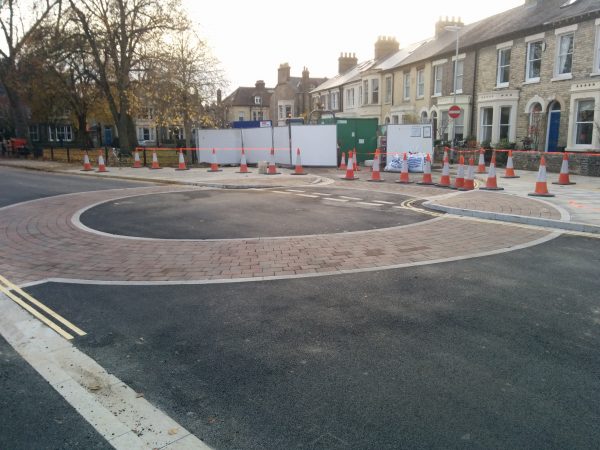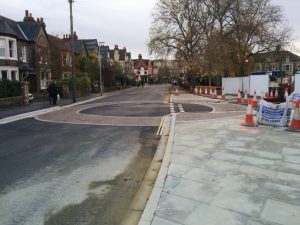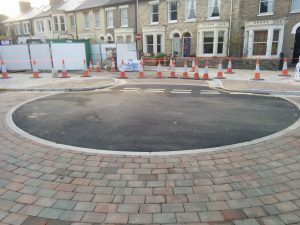A cobbled brick intervention along a road in Cambridge operates on a strange theory: confusing drivers will cause them to be more careful as they pass through residential and other reduced-speed zones.

This so-called “ghost roundabout” along Tenison Road looks a bit like either a vehicular roundabout or a pedestrian crosswalk but in fact serves neither function. It is simply meant to attract the attention of vehicle operators and get them to slow down as they drive by.
The traffic-calming revamp has been described as everything from a “UFO landing pad” and “urban crop circle” to a “free doughnut zone” and other less generous nicknames. It has faced criticism in the press and on social media since it was unveiled.

Richard Owen, who sits on a national road safety panel, described the design to the BBC as “reasonably unique” but suggested that “the behavioral science which sits behind it is quite good. It’s about making drivers feel much more uncertain about the road environment and that’s the way you slow cars down without using vertical humps.”
Representatives of local organizations like Camcycle (Cambridge Cycling Campaign), however, are skeptical of the short- and long-term efficacy of this intervention. Their own proposals for things like bollards (short posts) and alternate traffic routes are based on urban design precedents with demonstrable positive effects.

The impact of an unusual road feature like this ghost roundabout depends on surprise. But relying on novelty is a necessarily limited strategy. Once drivers pass through the area sufficient times it seems safe to assume that any calming effect will diminish (if not disappear). The approach also presents a problem in terms of replication. If each new iteration has to be unique to work, the approach could spawn a plethora of confusing urban configurations.
From the perspective of pedestrians, the brick also looks a bit like a crosswalk, which could also lead to ill-advised street crossings.

Coming at the problem from the opposite direction, there is evidence to suggest that reducing (rather than increasing) confusion can heighten a driver’s sense of risk.
The so-called “naked streets” movement, for instance, relies on stripping down road infrastructure rather than introducing new distractions. Without excess infrastructure or overt guidelines, drivers are forced to deal with conditions on the ground (and people around them) rather than relying on signs and other signals.
By a similar token, normal vehicular roundabouts (as in: the kind cars actually drive around in) have also been credited with reducing traffic speeds as well as collisions. Again, this seems to be in part a function of attention — drivers responding to their surroundings.
Meanwhile, the ghost roundabout is what it is and its effects remain to be seen. One could more generously view this as an experiment or prototype — if for some reason it ends up working better than bumps, cameras and other alternatives, perhaps it will be worth replicating or iterating. Of course, there is still the problem of novelty — copy it too many times and the strategy may become too familiar to function.



Comments (2)
Share
Here is the urban crop circle (or oval) I drive through regularly in Baltimore: https://www.google.com/maps/@39.3291159,-76.6180343,146m/data=!3m1!1e3
It is on the eastern edge of the Johns Hopkins Univ. Homewood campus. It does the job of sowing confusion and slowing traffic. My only concern is that I suspect many pedestrians confuse it for a crosswalk. In fact, that is what keeps traffic slow even after drivers become familiar with it.
Don’t forget the “crop circles” on San Francisco streets, which show where the cisterns are underground. http://99percentinvisible.org/article/decoding-rings-beneath-mysterious-brick-circles-san-francisco-streets/